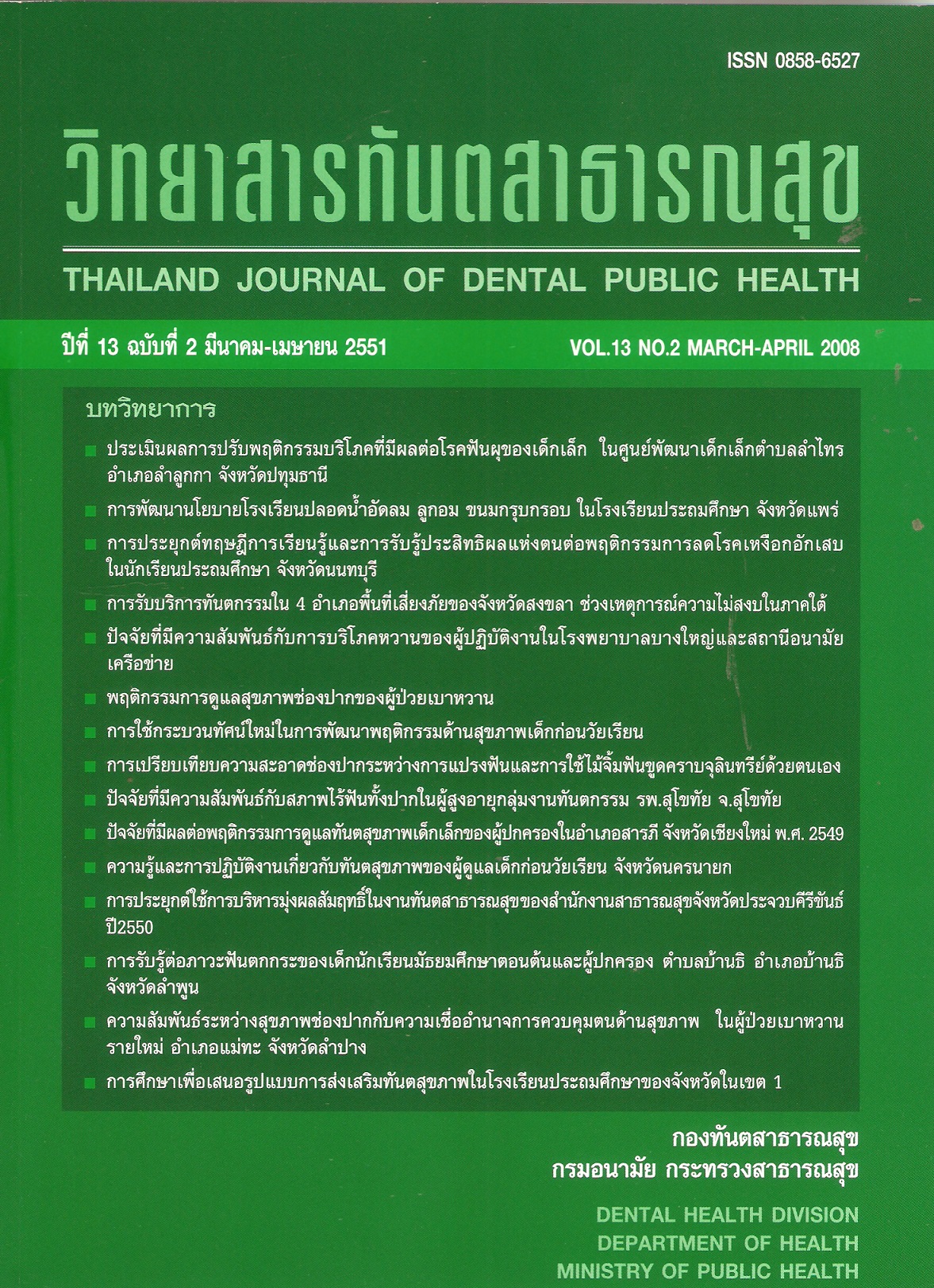Application of the Learning and Self - Efficacy Theories on Gingivitis Prevention Behavior among Primary School Students of Nonthaburi Province.
Main Article Content
Abstract
Gingivitis is one of the important public health problems and is a major cause of tooth loss. So, the researcher applied the learning and self-efficacy theories into oral health education program in order to assess the ability to reduce gingivitis problem in schoolchildren. This study was quasi - experimental research. The objective was to study the effectiveness of oral health education program to gingivitis reducing behaviors in primary school students of Nonthaburi province. The total number of sample size was 120 students, studying in grade 6 of primary school, equally divided into 2 groups including the experimental and control group in which Watchalermprakiet and Chumchonwatsaima school respectively. Collecting data used in this research including a questionnaire, a note of community periodontal index, a note of hygiene analysis index, a note of brushing teeth, and a questionnaire of the sense after using toothpicks. The data was collected into 3 phases including before experiment, between experiment, and after experiment in the total period of 3 months from June to August 2007. The statistics were used by descriptive statistics including frequency and percentage, and analysis statistics including Paired Sample t-test, Independent Sample t-test, and Proportion test (Z-test). The result was found that the oral health education program could change the behaviors of knowledge, attitude, and the true practice of the samples in gingivitis prevention and caries more than before joining in the program significantly at the level of 0.05. These findings can be applied for the supportive acts of primary school in order to reduce the gingivitis problem and promote the oral health better.
Downloads
Article Details
References
2. กองทันตสาธารณสุข กรมอนามัย กระทรวงสาธารณสุข รายงานผลการสํารวจสภาวะ ทันตสุขภาพแห่งชาติ ครั้งที่ 4 พ.ศ.2537 ประเทศไทย. นนทบุรี: กองทันตสาธารณสุข กรมอนามัย.กองทันตสาธารณสุข กรมอนามัย, 2538: 22.
3. กองทันตสาธารณสุข กรมอนามัย กระทรวงสาธารณสุข, รายงานผลการสํารวจสภาวะ ทันตสุขภาพแห่งชาติ ครั้งที่ 5 พ.ศ. 2543-2544. นนทบุรี: กองทันตสาธารณสุข กรมอนามัย,2545: 33 - 37.
4. งานทันตสาธารณสุข สํานักงานสาธารณสุขจังหวัดนนทบุรี, สรุปผลการสํารวจสภาวะ ทันตสุขภาพของประชากรจังหวัดนนทบุรี ปี 2535-2540: อัดสําเนา
5. งานทันตสาธารณสุข สํานักงานสาธารณสุข จังหวัดนนทบุรี, สรุปผลการสํารวจสภาวะ ทันตสุขภาพของประชากรจังหวัดนนทบุรี ปี 2548-2549: อัดสําเนา
6. ภาควิชาทันตกรรมชุมชน คณะทันตแพทยศาสตร์ มหาวิทยาลัยเชียงใหม่.การควบคุมแผ่นคราบ จุลินทรีย์ (Plague Control) เอกสารประกอบ การประชุมเชิงปฏิบัติการเพื่อจัดทําเครื่องมือ การแปรงฟันอย่างมีประสิทธิภาพ โดยใช้ กระบวนการเรียนการสอนแบบมีส่วนร่วม 1 – 3 กุมภาพันธ์ 2543 ณ โรงแรมการ์เด้นท์ นครปฐม
7. งานทันตสาธารณสุข สํานักงานสาธารณสุข จังหวัดนนทบุรี, สรุปผลการสํารวจสภาวะ ทันตสุขภาพของประชากรจังหวัดนนทบุรี ปี 2535-2540: อัดสําเนา
8. กองทันตสาธารณสุข กรมอนามัย กระทรวงสาธารณสุข. รายงานผลการสํารวจสภาวะ ทันตสุขภาพแห่งชาติ ครั้งที่ 5 พ.ศ.2543-2544 นนทบุรี, 2545: 11
9. งานทันตสาธารณสุข สํานักงานสาธารณสุขจังหวัดนนทบุรี, ประสิทธิผลของไม้จิ้มฟัน ในการกําจัดคราบจุลินทรีย์ ศึกษาในนักเรียน ชั้นประถมศึกษาปีที่ 6 โรงเรียนวัดแจ้งศิริสัมพันธ์ อําเภอเมือง จังหวัดนนทบุรี, 2543 : บทคัดย่อ
10. Bandura, A. Self-efficacy: Toward a Unifying Theory of Behavioral Change. Psychological Review, 84, 1977: 19-21.
11. WHO “Prevention methods and program for oral disease.” WHO Technical Report Series 1984:20-21.
12. William D. Love, Juan M. Ramirez baz R. Paul Fultz อ้างถึงใน ปาริชาต ฉายสีศิริ ประสิทธิผลของโปรแกรมทันตสุขศึกษาต่อการ ลดโรคเหงือกอักเสบ ในกลุ่มนักเรียนชั้น มัธยมศึกษาตอนปลาย ในเขตกรุงเทพมหานคร วิทยานิพนธ์ปริญญาวิทยาศาสตรมหาบัณฑิต (สาธารณสุขศาสตร์), สาขาสุขศึกษา บัณฑิตวิทยาลัย มหาวิทยาลัยมหิดล, 2534: 39.
13. Sarner B, Birkhed D, Huysmans MC, Ruben JL, Filder V, Lingstrom P. Effect of fluoridated toothpicks and dental flosses on enamel and dentine and on plaque composition in situ. Caries Res 2005; 39:52-9.
14. Walsh MM, Heckman BH, Moreauer R. Use of gingival bleeding for reinforcement of oral home care behavior. Community Dent Oral Epidemiol 1985; 13:133-5.
15. Yankell SL, Shi X, Emling RC. Comparative laboratory evaluation of two new toothbrushes regarding interproximal access efficacy. J Clin Dent 1993; 4:D1-D4.
16. Yankell SL, Shi X, Emling RC. Laboratory interproximal access efficacy comparison of a rippled bristle toothbrush and a flat manual toothbrush. J Clin Dent 1993; 4:82-4.
17. Brandtzaed, P. and Jamison, H.C. “The Effects of Controlled Cleaning of the teeth on periodontal Health and oral Hygiene in Norwegian. Army Recruits.” Journal of periodontology 35


